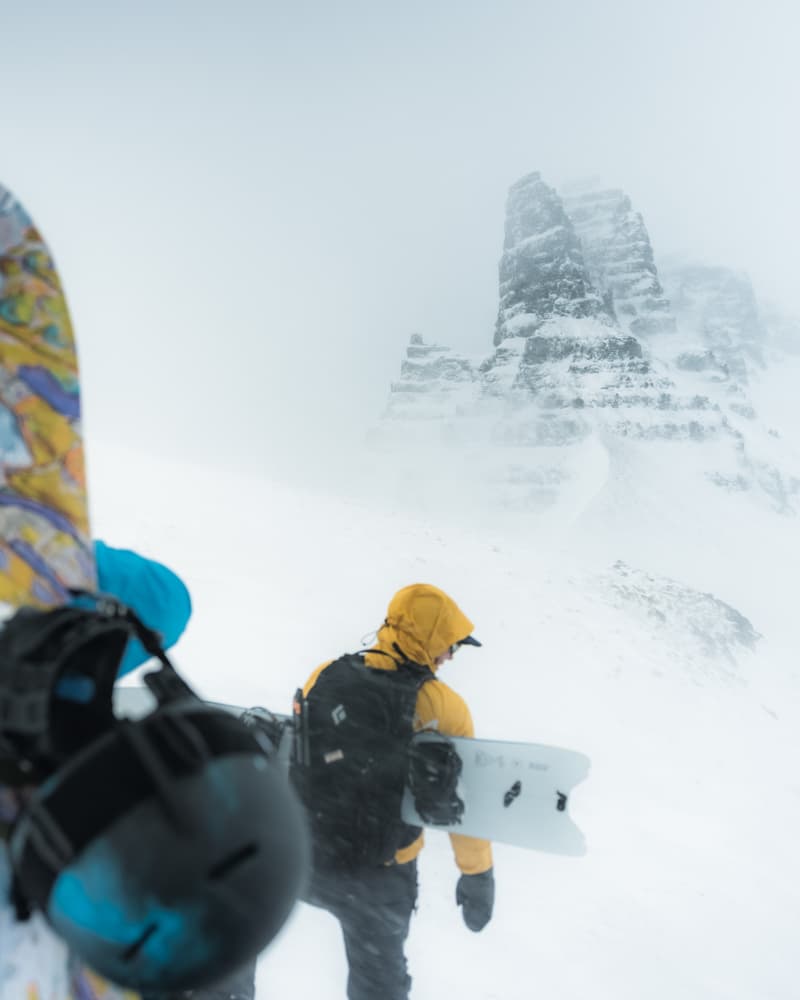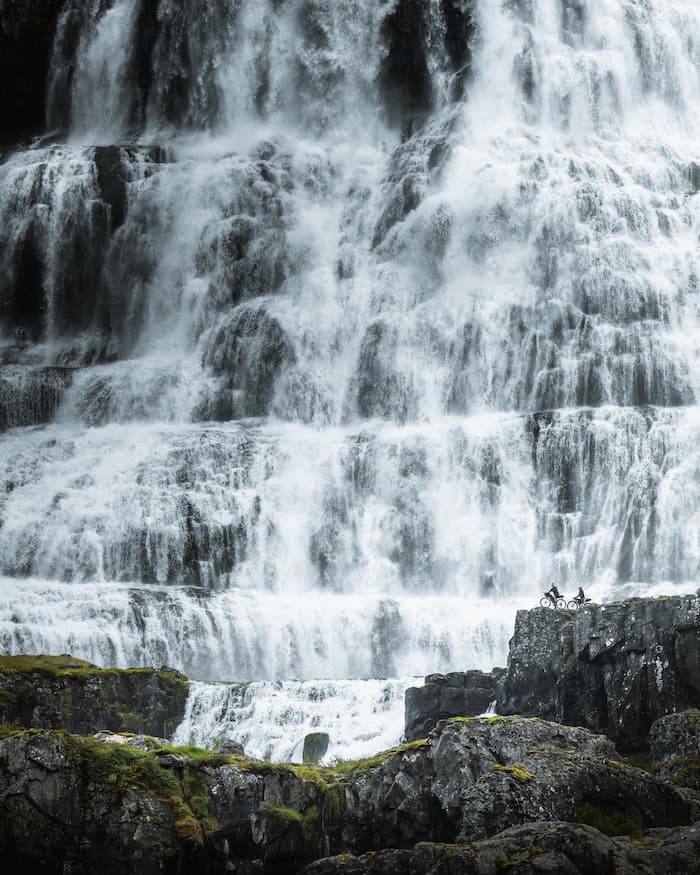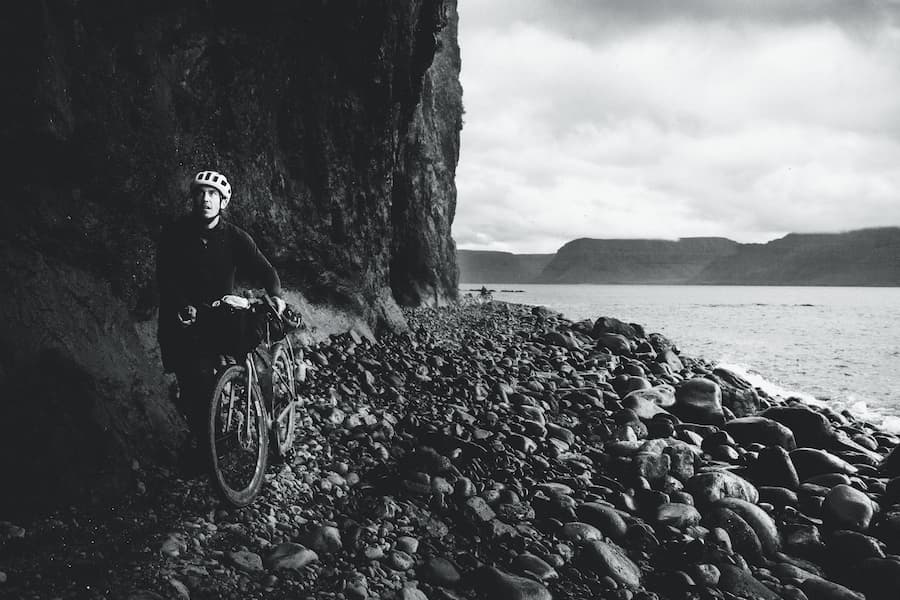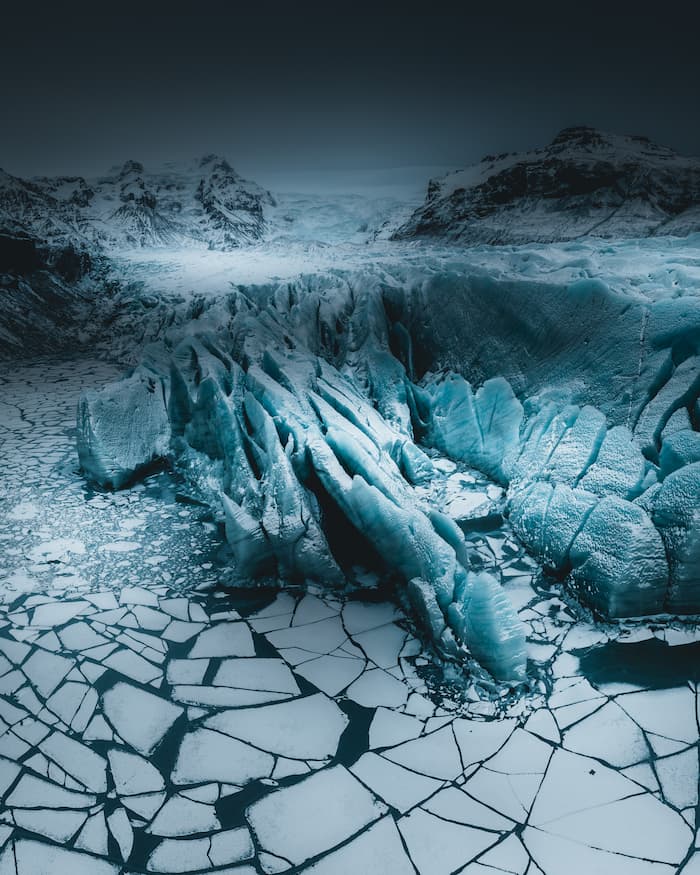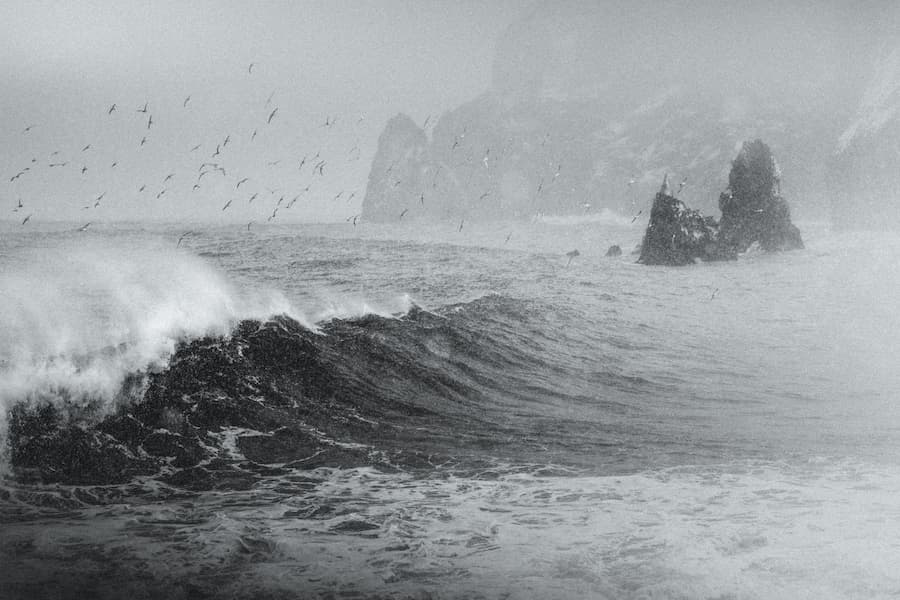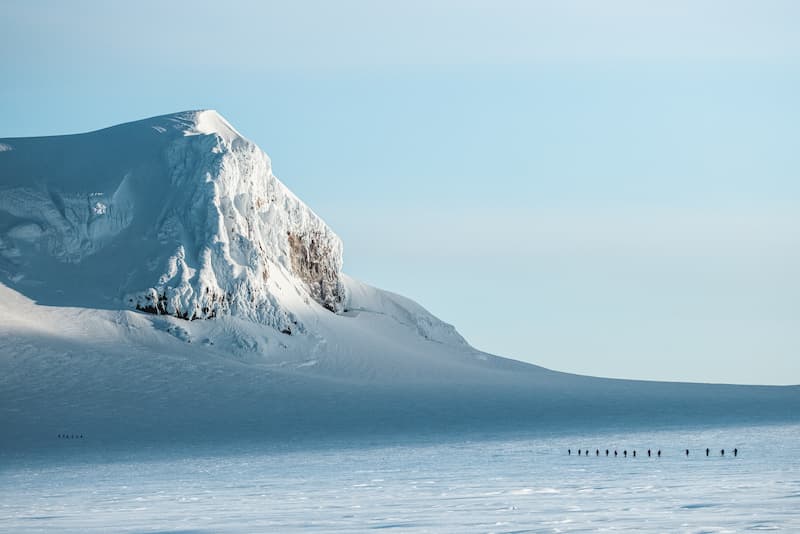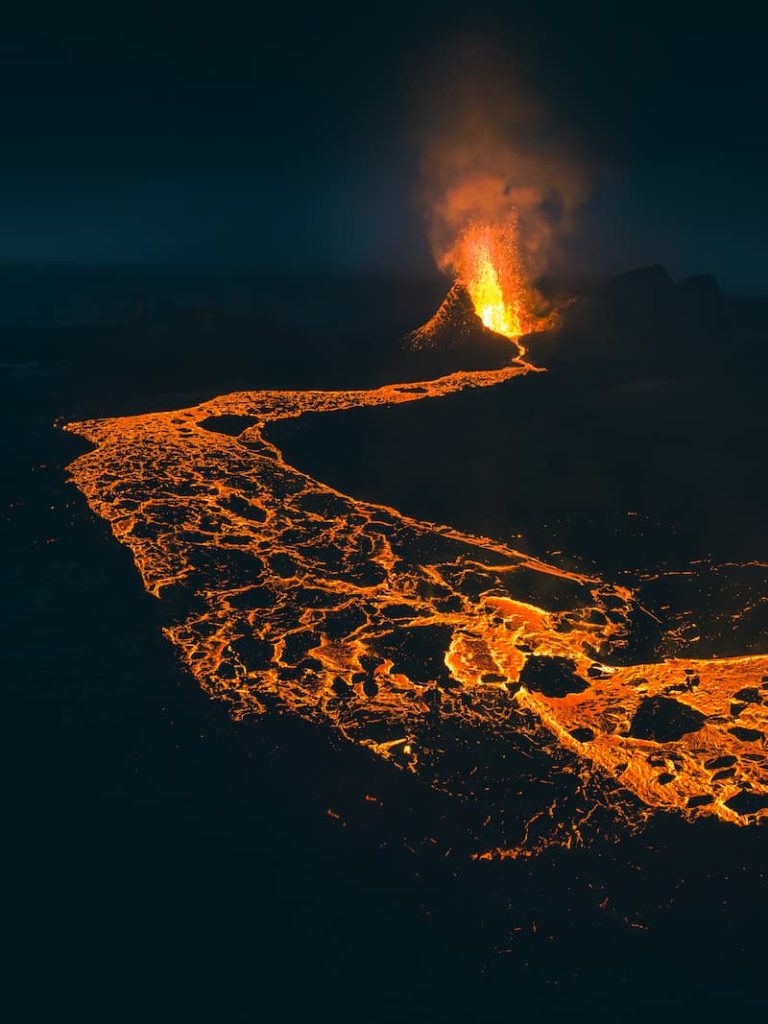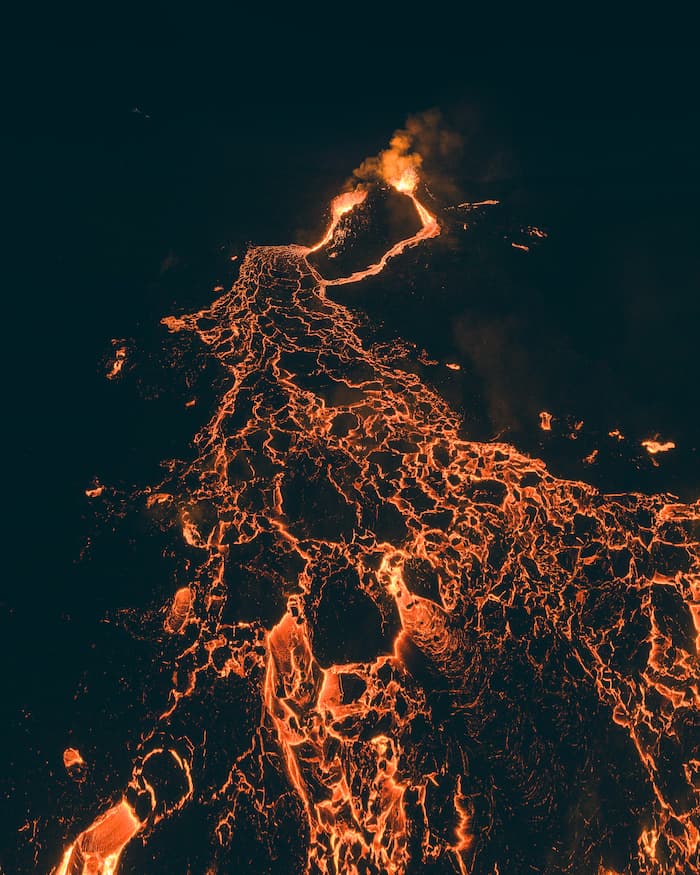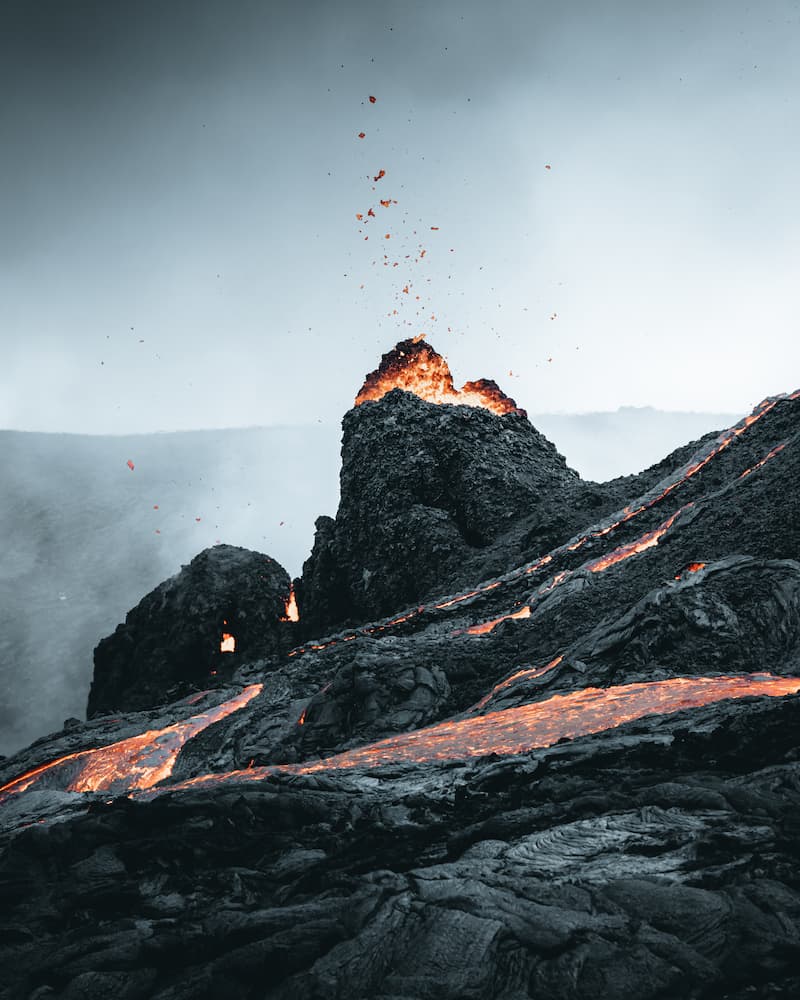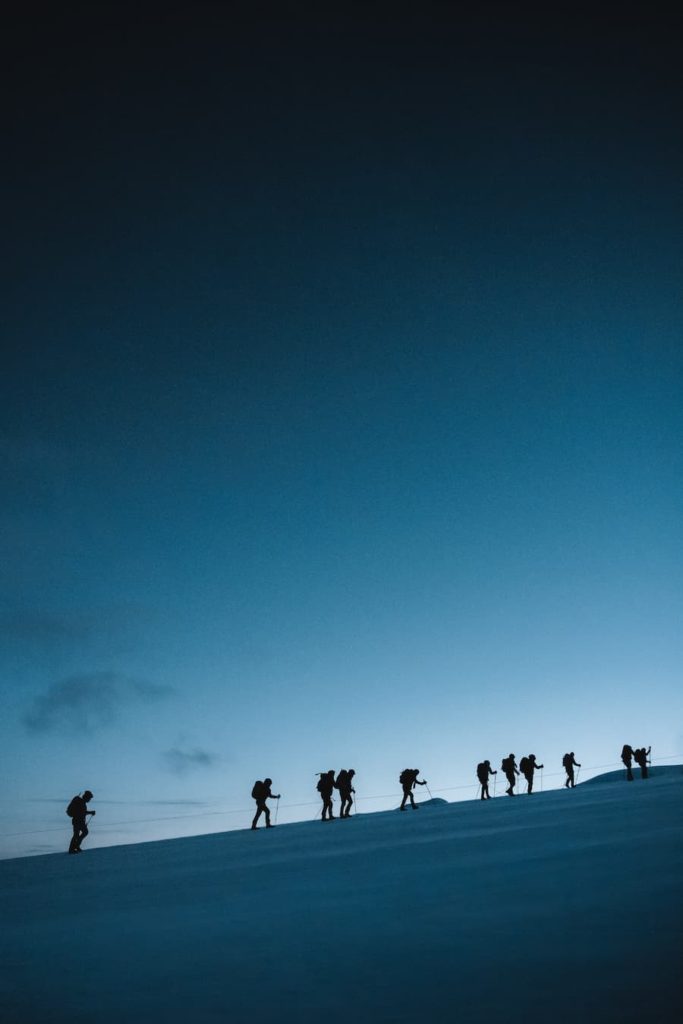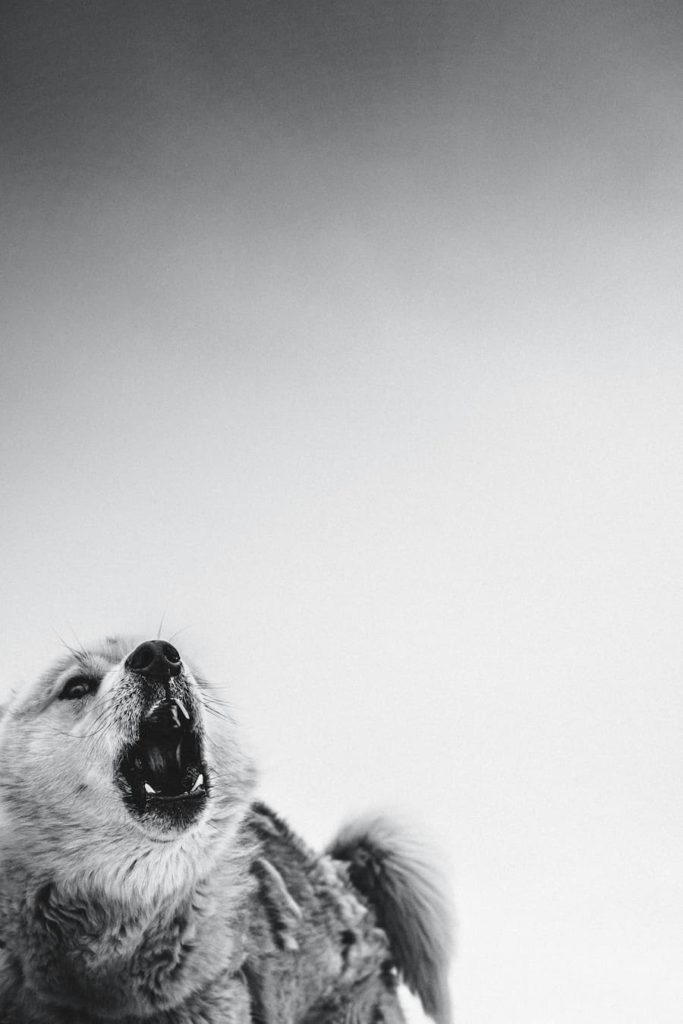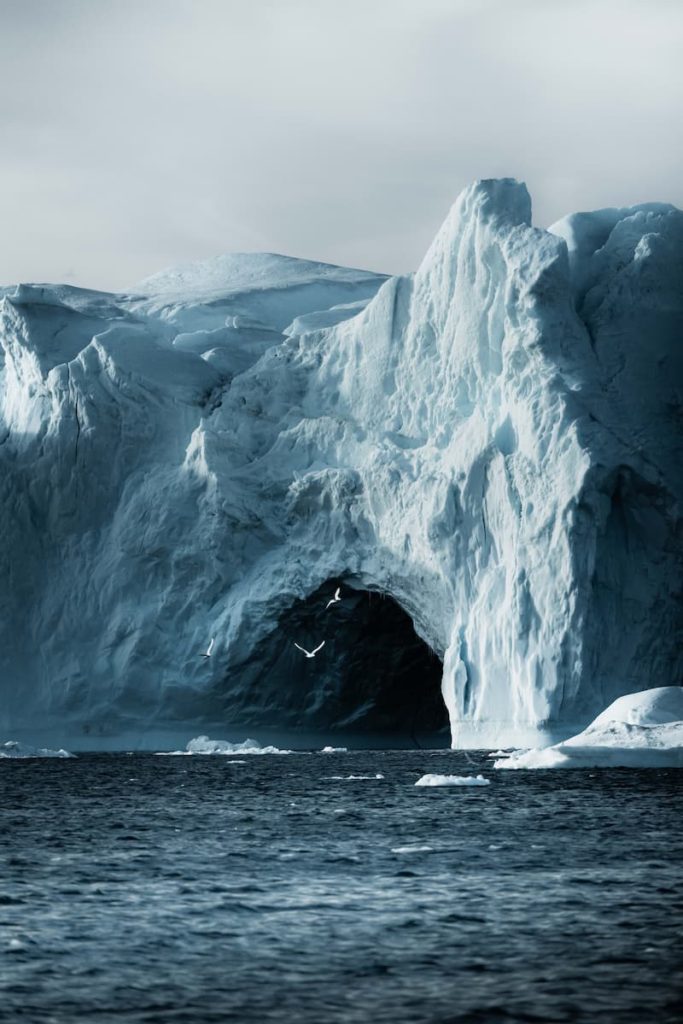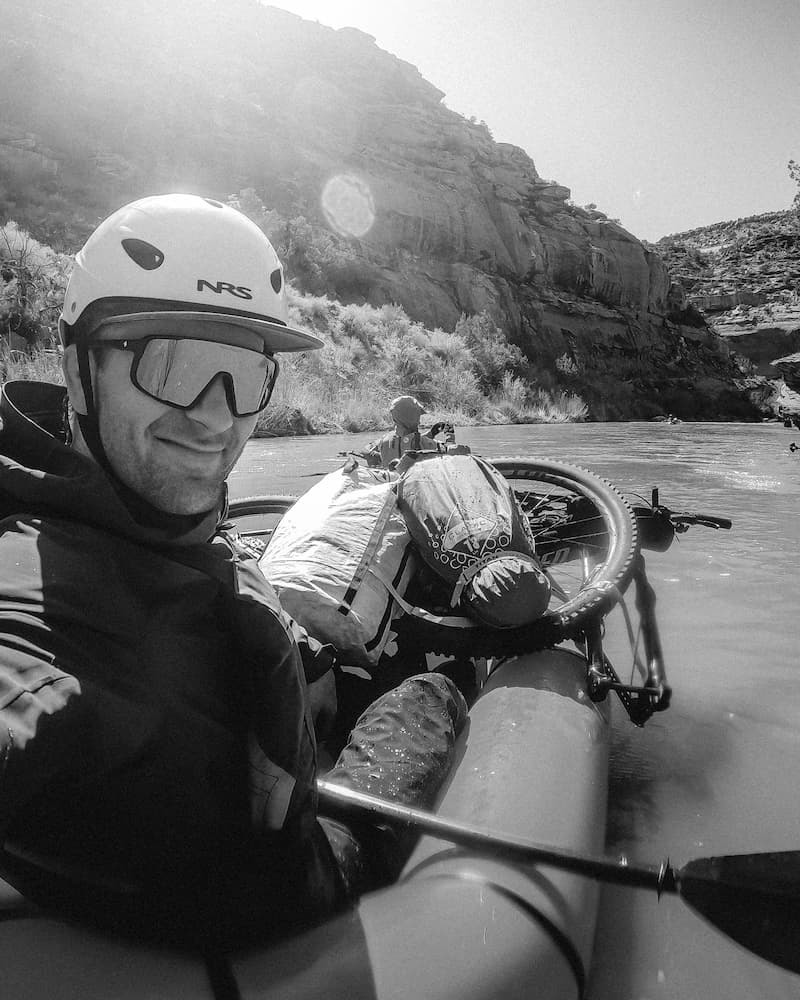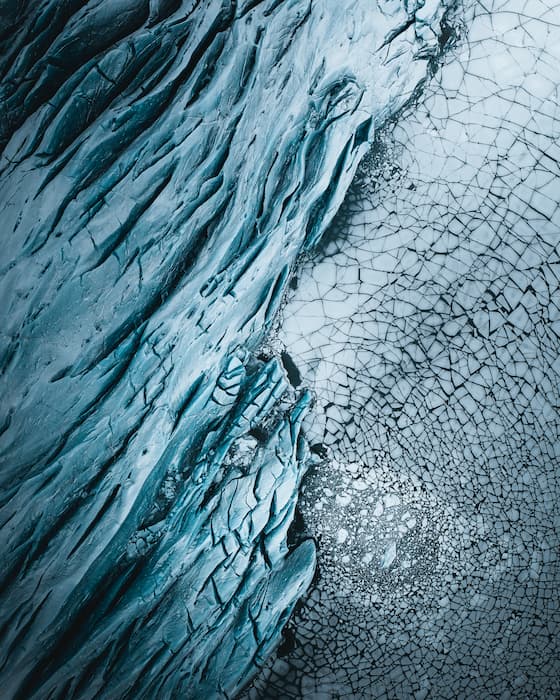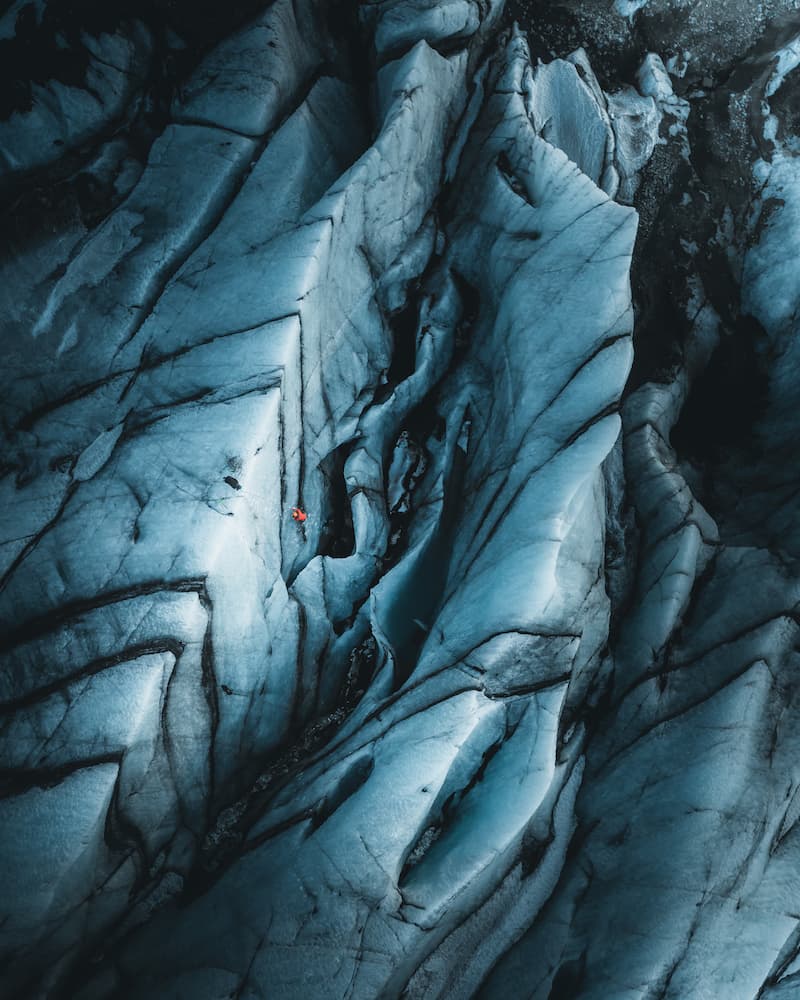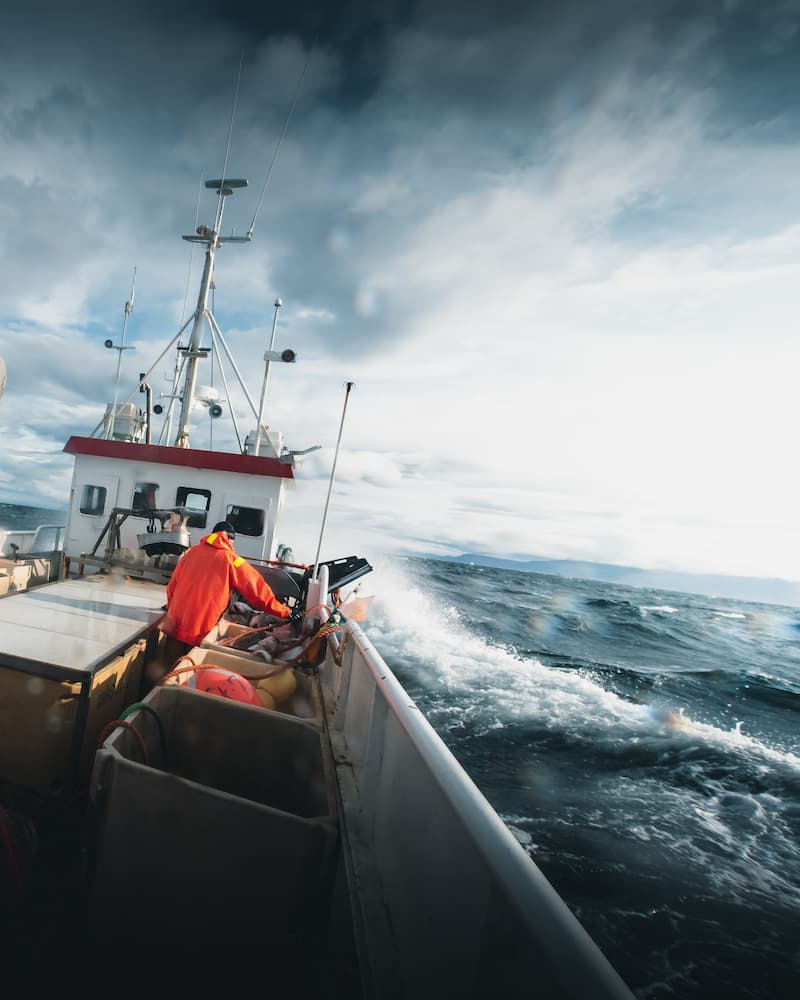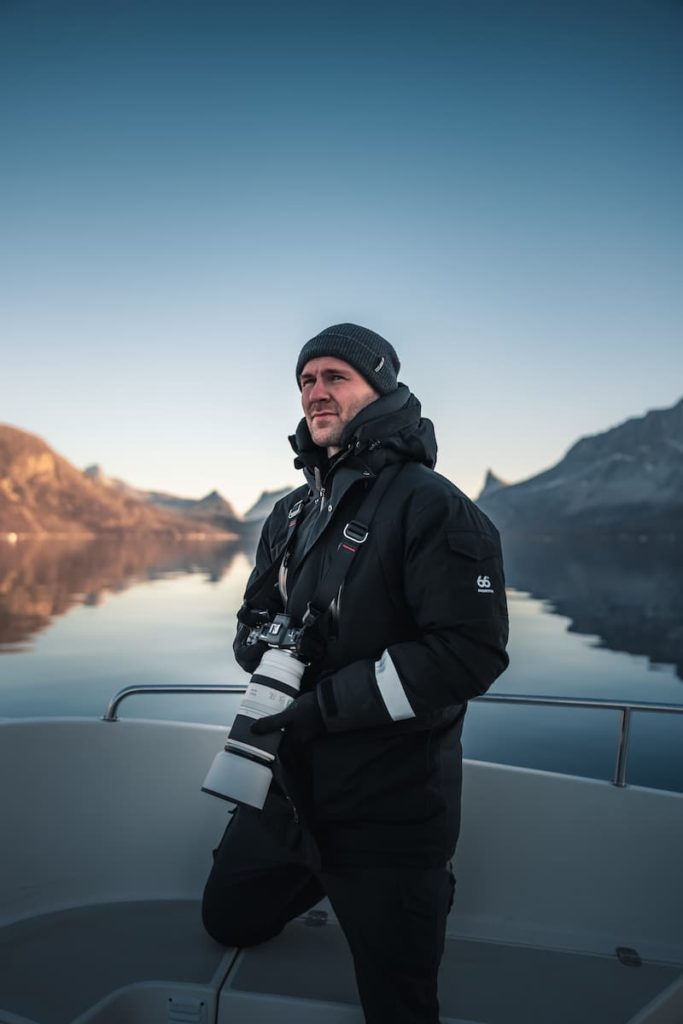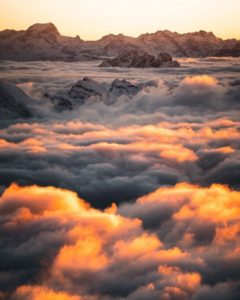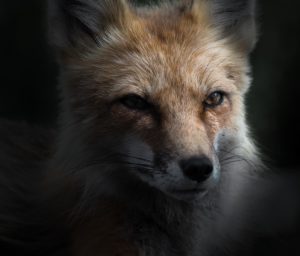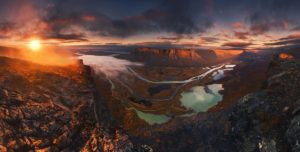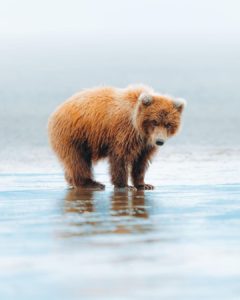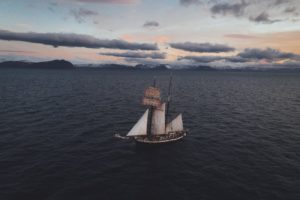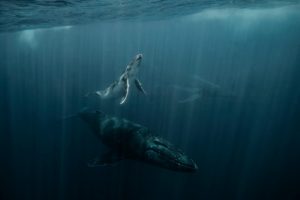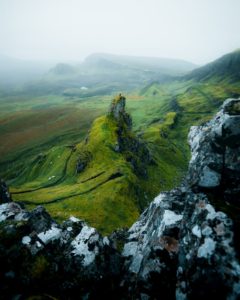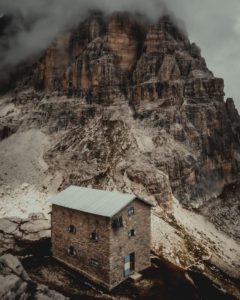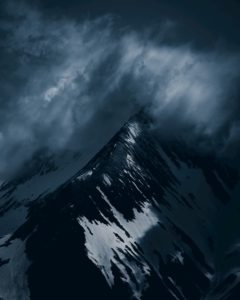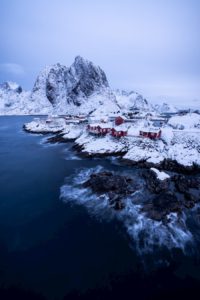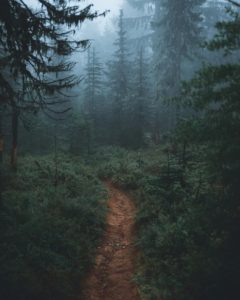
Thrainn Kolbeinsson
@thrainnko
Photographer based in Iceland
At the beginning of Thainn’s career (and in the early days of Nomadict), we created an article with Thrainn. His business and skills have grown tremendously since then, including work for National Geographic, Nissan, Icelandair and others, so it was time to do another interview. His main challenge has been moving into doing video: “I almost exclusively focused on photography until I was offered to make a film with Chris Burkard, Lael Wilcox, Rugile Kaladyte, Payson Mcelveen, and Nichole Baker about bikepacking around the entire Westfjords in Iceland.” By starting with video, lots of new challenges came onto his path, which also meant pushing his limits and moving forward with his career.
Thrainn has a family with two small children, so growing and running a production business that revolves around outdoor adventures has taught him to be more precise and focused in his work. “I would advise anyone wanting a sustainable career as a content creator to mostly stay away from free work and exposure deals. We’re all worth way more than we think in the beginning.” For Thrainn it has become clear over the years that, yes, you need to work on a few spec projects and create a portfolio. Nonetheless, you also need to create and share things that you are proud of and are in line with your values: “I want to make things that I enjoy making. At the end of each year, I want to be able to look back and feel that I created things of substance and meaning. Simply put, I want to be able to focus on my personal creative journey.”
In the interview, Thainn goes deeper into developing your business and shares a few best practices about working successfully on client projects. In short: 1) Details 2) No worries 3) One team and 4) Don’t get bitter. He elaborated on each point in the interview which you can read by clicking on the link in our bio. As in all our interviews, Thrainn also gave four valuable pieces of advice about pursuing a full-time career as a visual creator.
In addition, as a local to Iceland, Thrainn shared some great tips and information on shooting and flying over an erupting volcano. “Shooting an eruption has been a fun and steep learning process”, he says. “So far I’ve probably emptied between 100 and 200 batteries flying over the spewing volcano and hot lava without a serious crash or burn (so far!), but there have definitely been a few close calls.”
To know more, keep reading!
Interview
Welcome! We shared a story with you quite some time ago, almost at the start from Nomadict. Would you like to guide us through some of the main developments you have gone through? How have you evolved as a creative?
That’s right! I remember – I think it was pretty early in my career as well. It’s been impressive and fun to watch the solid growth of Nomadict since then. A lot has happened during that time for me as well. The highlight was definitely that our second child was born but my business has also grown a lot which has made me have to earn a lot on the go. It’s definitely not straightforward work so you’re bound to make some mistakes on the way but I honestly think that’s a good thing. It means you’re taking chances and putting yourself out there. For all that has changed, one thing that has not changed since we last spoke is that it’s still the same fun – just more work.
Aside from being busier than ever, I think the main change for me is that I’m also doing video. I almost exclusively focused on photography until I was offered to make a film about an incredible adventure with Chris Burkard, Lael Wilcox, Rugile Kaladyte, Payson Mcelveen, and Nichole Baker where they bikepacked around the entire Westfjords in Iceland (watch the result here). It turned out to be one of my all-time favorite projects while also allowing me to meet and get to know some amazing people. Chris has been one of my biggest inspirations since starting photography and it’s an honor to be able to call him a friend at this point. They say “never meet your heroes” but this time it couldn’t have been further from the truth. He’s an awesome human. Slowly after that project, video work started filling up more and more of my schedule. I really like doing videos and even though it’s obviously similar to photography in many ways, you have to approach it with a very different mindset. With the high demand for video content, I think it definitely makes sense to be able to do both photos and video, even though your main focus might be one or the other.
Overall as a creative, I feel I’ve turned more towards telling stories of actual people instead of pure landscapes. Even though I still love shooting landscapes, I really get the most joy when there’s a human being interacting with that landscape in some way.
"But the big constant for me has always been just spending time outside, no matter what the objective is."
You have worked on several projects and with several companies. How did you find clients at the beginning as a creator and what “best practices” have you learned to successfully work on client projects/with clients?
My first goal was simply to get better at photography – both shooting and editing. After that, it was all about staying visible and consistent on social media and reaching out to possible clients. In the beginning, my process was really sporadic and aimless since I didn’t really know the next steps. If I’d be starting now, I would do things a lot differently. I would still start by improving my skills and then work on a few spec projects (speculative work, non-paid and not necessarily for a specific client) and create a portfolio in the niche I was interested to work in. I’d do those “projects” as well as I could, just like I would if they were actual projects for paying clients. After that, I would find a way to present my work in an appealing way and start reaching out to possible clients. It’s hard to expect companies to be willing to pay you what you’re worth when they have no idea about your qualities and skills.
A “few best practices” in my opinion:
Details. Spend more time before every shoot to find out what the client actually wants from you and what problems they’re trying to solve with your work. Get as many details as possible. It will make your work way more focused. What is the goal of the shoot? Where and how will the content be used? How much content do they need? Can they show you content that they like or don’t like?
No worries. Don’t let your clients worry about you or the project. Create trust by giving status updates every now and then, especially if something is taking longer than expected.
One team. Create an atmosphere where you and the client feel you’re working together as a team towards the same goal. As soon as money comes into play, things can start to feel more tense. Know your worth and what you are willing and able to do for different amounts and be open to scaling projects to different budgets. All that being said, don’t get pushed over either – but make sure to get your message across in a positive way.
Don’t get bitter. Don’t do work for free or for amounts that you’re not happy with unless you’re certain it won’t make you bitter. There can definitely be moments where low-paid projects can make sense but the main thing is that it doesn’t negatively affect the content you’re creating or your relationship with the client.
What has been one of the most awesome projects you have worked on and what did you like so much about it?
I’ve been very privileged with projects and clients over the last years so it feels hard to pick just one. My favorite things to shoot are real adventures and challenges in the outdoors and one project that definitely ticks most of the boxes for me is the time I documented a group of 126 women hiking to the highest peak of Iceland. It was a charity event and I was there on assignment for 66°North. The groups started at midnight, hiking through the cold night while the snow was still hard. The sky was clear and I remember going ahead and then looking back to see this perfect line of headlamps, ascending slowly but steadily in the dark. At one point I stopped for about 20 minutes to get a few drone shots of the groups, hopefully with the distant peak in the frame for some perspective. It was definitely a good call but while I was doing it I didn’t realize I was losing feeling in all my toes. When I was done I kept going and didn’t really feel them again until we reached the first plateau and the sun came up. Living in Iceland I’m always glad to see the sun, but that time I was extra thankful.
It was interesting watching the groups’ atmosphere change throughout the night and into the next day; going from excitement in the beginning to a more focused state during the night and then pure happiness as they reached the top after the final push. That was definitely my highlight. It’s hard to beat real and strong emotions when it comes to documenting people and that day there was no lack of those. With so many visually interesting moments and positive emotions during those 17 hours, I feel very grateful for having had the opportunity to experience and document the event.
You are native to Iceland and have explored lots of its land, including the many eruptions. How have you learned to shoot the eruption in a proper manner? What settings and strategies are most effective to get good results?
Shooting an eruption has been a fun and steep learning process. Personally, I want to push my gear and myself as much as possible, which can obviously be tricky when an active volcano is part of the equation. You also never know if it’s going to last a few hours, days, months, or even longer.
So far, my overall strategy has been to start with all the basic and straightforward shots just to get them out of the way. These are mostly overview-shots, showing the whole area, crater/s, and main features. Shots that don’t take too much thought to capture. After that, I slow down quite a bit, look around and simply stay present while I look for interesting and unique ways to document the scene. You also never know how it will unfold, if a crack will open in the crater or a new river of lava will appear, so you have to stay pretty alert.
Personally, I like having one or a few different themes in mind during each visit. That makes me more able to focus on and get more interesting shots within those themes than if I’d just be there shooting something. Those themes can be textures, people, details, minimalism, close-ups, aerials, etc. Even if I’d only have one chance to visit an eruption I’d still try to pick a few themes and keep them in mind while looking for shots. I usually end up shooting something of everything but with more emphasis on the themes in mind.
If I’d have to give some technical advice on shooting an active eruption, I think it would be on exposing correctly. We all have different compositional preferences and we like shooting different things, but in general, I think we all like to expose our shots as evenly as possible. When I first shot the volcano I had a hard time doing this since the brightness in the lava is surprisingly intense. That, in combination with the dark solidified lava all around it makes it hard to not lose details in either the shadows or highlights. The classic method is to underexpose for the highlights and I would still recommend that here, but more. Go even darker. You’ll be surprised at how easy it is to lose details in the lava.
You’ve also flown your drone above the lava being spit in the air. How was the experience? How far can you go and what is the limit for you to keep the control and get the drone back (maybe slightly melted, but still in good shape)?
Flying a drone over an active volcano has definitely been a fun learning experience – and sketchy at times (you don’t get a lot of second chances over there). The main problem is obviously the heat. The lava is around 1200°C before it starts cooling down, but even after it has a solid-looking crust, it’s still insanely hot. So far I’ve probably emptied between 100 and 200 batteries flying over the spewing volcano and hot lava without a serious crash or burn (so far!), but there have definitely been a few close calls. Here’s a few tips and information that might come in handy for those wanting to fly over an active volcano.
SD cards. This is generally a good rule when you’re capturing content you really don’t want to lose but I’d say it’s especially important when flying over an active volcano. Bring a lot of SD cards. Personally, I put in a fresh SD card after every flight to make sure I don’t lose any material. That way, if you lose your drone you at least have some volcano content already and you can go home and edit while you cry about your drone. Crying while editing volcano footage is always better than just crying.
How close? DISCLAIMER: I did melt my drone a little bit during some of my flights so maybe I’m not the best person to be speaking on this. Still, I’ve never lost a drone to the volcano and they have functioned 100% since the eruption until one of them crashed in the ocean a few months back.
So, how close can you fly? There are many variables that make this a tricky thing to assess (weather, size of the eruption, amount of flowing lava, power of the volcano, etc.) but the main thing you need to be aware of is how high you are compared to the danger zone. Since the displayed altitude of your drone is most often measured from its takeover altitude (and not its current altitude above the ground beneath it) you have to keep that in mind. The closest I’ve been over running lava is somewhere around 10 meters but I wasn’t there for long and there’s a big difference between running (orange lava) and solidified (black/grey). The running lava is obviously way hotter but the solidified parts are still insanely hot.
Flying over the volcano itself is an entirely different story and can be very hard to get a feel for. Since the volcano is always changing and every pulse and splatter are different you’re really counting on luck if you want to go really close. I think I was somewhere around 50-70 meters above an active crater at some points but those times it wasn’t very active and again, it did melt a bit. The craters and the amount of lava are so variable that it’s hard to give a concrete answer about a safe altitude. In general, if you don’t want any deformities on your drone, I think if you stay around 40-50 meters above the lava and probably around 100 above the volcano/fissure you should be fine. Just don’t stay there for too long. One thing you can do to keep a safe distance is using some kind of zoom or crop-in mode, if possible.
In general, I would approach this in a few steps. Try to get level to the volcano itself and then flight by flight, go a little bit closer to the heat. Take note of your height and inspect the drone after each flight. That way you slowly get a feeling of how close you can get.
How do you approach the editing of the reels you’ve shared? What are your most needed/preferred tools, and what helps you to achieve the final result?
Reels are interesting. It’s like a lottery where everyone is trying to score big. I quickly decided not to give in to following the main trends, even though the chances of virality are the biggest there. It was just a personal decision and I’ll explain why. I want to create and share things that I am proud of. I want to make things that I enjoy making. At the end of each year, I want to be able to look back and feel that I created things of substance and meaning. Simply put, I want to be able to focus on my personal creative journey.
I think everyone has heard the saying “think outside the box”. I believe following trends and chasing views are sure ways to put your creativity in a box. Creativity is a trait that can be learned and trained, which is what every creative should be doing in my opinion. When creativity is constantly being limited for the sake of likes and views, it won’t grow and evolve. It will stay the same and keep molding along whatever trends are buzzing each time. My favorite creators all have a specific and unique style and I want to be able to differentiate my work from the work of others too.
To answer the question, I edit all videos in Premiere Pro and I try to approach the process without wondering if it will get many views or likes. Without wondering if the masses will like it or not. That way I feel I’m creating something personal and unique to me while also progressing as a creative. Obviously, there’s some kind of middle ground there, but I personally like to stay as far away as possible from the powerful pull of views and likes.
What do your outdoor adventures look like when you decide to go out shooting or exploring? How do you prepare, scout, and travel around your home country that you already know so well?
For the last two years my travels have mostly either been for work or with the family. Assignments usually have a predefined time frame but sometimes they’re just roughly planned at a certain season. The seasons in Iceland can vary a lot from year to year and the weather is notoriously unpredictable, so it’s better to have some wiggle room to adjust for that.
When preparing for a trip I always look at the weather forecast. I’m not really sure why because then I basically pack for anything since it can change so quickly. The gear always changes depending on the objective of the trip or project but I want to avoid the combination of cold and wet as much as possible so I almost always bring waterproofs and wool layers, just in case.
Usually, I like to have some flexibility when it comes to locations (unless it’s part of the brief). The weather and light can change so quickly that I really need to be on my toes when shooting in Iceland. When the light is good, we shoot. I’ve also been becoming more and more interested in lesser-known places and more subtle backdrops and surroundings. I’ll rarely say no to huge waterfalls and epic mountains, but I also like them combined with less obvious locations.
I spend a lot of time scouting for interesting locations for future projects and travels. I mostly use photo books, maps, and obviously the big ol’ internet. I’d recommend everyone look outside the main social media platforms for fresh locations. There’s so much out there that isn’t being explored or shared.
What has been one of your most remarkable experiences traveling so far? What made it so special?
There are many that come to mind but two quickly stand out.
Greenland. Last year I went on an assignment in Greenland which was a surreal experience from start to finish. I know “surreal” is a word we probably throw around more than we should but looking back, this trip literally feels like a dream. I’m not sure what it was exactly, but I had been wanting to go there for many years before it finally happened. Even though it was very different from what I expected, it also exceeded my expectations in many different ways. The landscapes and the views are obviously incredible and something I’d never seen before. But there’s something about the atmosphere over there, the colors and the light, that really sticks with me. I’m still trying to figure out what it was exactly but all I know is I must go back and the sooner the better. I know one thing that definitely played into that positive experience and that’s that I went there with two friends. Sharing all those views and moments with others definitely made the trip more memorable and special.
One of my favorite experiences was sailing among the icebergs I had spent so much time looking at photos of. We paid a local fisherman, John, to take us on a boat ride around the Ilulissat Icefjord. It was incredible to finally get close to those giant chunks of ice and get some sense of their immense scale. It wasn’t until dinner that night that we heard that, apparently, John is known to be especially bold when it comes to sailing close to the icebergs. Which made a lot of sense when we looked back on some of the moments. It was nice to know after the fact rather than before.
Pro tip: If and when you visit Greenland, make sure you get a window seat. Make up aerophobia, use your kid for sympathy or just take it and pretend to be asleep when someone asks you to leave. Get that window seat. Simply flying over there is worth it in and of itself.
Bikerafting in Colorado. Earlier this year I got the chance to go bikerafting in Colorado with Chris Burkard, Steve Fassbinder, Chas Christiansen, and Patrick Hendry. For those that don’t know (like me just a year ago), bikerafting is when you incorporate a bike onto a packraft, switching between the bike and the raft as necessary to get where you want to go. Steve Fassbinder is a true pioneer in the world of bikerafting, an outdoor legend, and just an awesome human being. He and his wife, Lizzy Scully, run a guiding service called Four Corners Guides which I couldn’t praise enough. The trip was meant as a preparatory trip for a pretty crazy bikerafting expedition in Iceland which Chris has already completed this summer.
This was the first time I experienced any serious outdoor adventures in a non-Arctic environment. From the moment I stepped out of my plane in Denver I felt like I was in a Western film. I wanted to buy a cowboy hat straight away. That feeling only grew stronger after meeting Steve and Lizzy and going to their Scullbinder Ranch deep in wild Mancos, Colorado. We did some packraft training for a couple of days, ate delicious food and I did my best to soak in all the new things I was experiencing. After that, we drove into the desert for a two-day bikerafting trip in the Dolores Canyon. Speaking of experiencing new things, it was actually just the beginning. The next 48 hours included some of the most unique outdoor experiences I’ve had for a very long time. From getting my first ever “howdy” to paddling through rapids with a bike on the raft and sleeping under the stars with a bat flying above me. For me, it feels like content for a whole book while it was all standard stuff for Steve. It was an interesting reminder of the way many people from different parts of the world must experience Iceland when they come here for the first time (compared to how I experience it as a local).
Nowadays we see many young talented artists pursuing a career as (full-time) travel/landscape photographers. What four pieces of advice would you give them?
1) Find out what you like. When you’re starting out, shoot all sorts of stuff and figure out what you like to do. If that turns out to be travel/landscape photography, figure out what kind you want to specialize in – and don’t simply try to do the same route as the rest. That might be shooting something specific or maybe you mostly like editing. It might be a special kind of environment or activities you find the most appealing. In my opinion, the more you know yourself, the more specific you can get as a professional. Basically, find out what you love the most, go all-in on that, and don’t waste time getting good at things you don’t like doing.
2) Don’t follow trends just because they’re trendy (keep reading for the exception). With algorithms heavily favoring short-form videos at the moment with everyone hoping to win the viral lottery, trends seem to be hijacking creativity in a big way. It is what it is but before you jump on the next trend just because everyone else is doing it, think about what your goals are and how it fits with your brand and your image. In my opinion, trends generally don’t age well, and following them might not result in the content you’re proud of. In addition, they’re constantly changing so you’ll find yourself chasing trend after trend while staying where the most competition is. But most importantly, you might not be impressing the people or brands you actually want to impress with your content.
Now for the exception: If you like the current trends or if your main goal is to be an influencer, those are different stories. Before you start spending an unhealthy amount of time on social media, decide if you want to be a photographer or an influencer (and if both, figure out in which ratio). If you mainly strive to be a professional photographer, you can “waste” a lot of time following trends to grow on social media – Time that could be spent honing your photography/editing skills, making your website, building relationships with clients or other creatives, working on your portfolio or actual projects, etc. So many photographers have successful careers with very little focus on social media. We all have different goals and we need to utilize our tools with those goals in mind. Social media is a tool, use it for your own good.
3) Connect with other creators. Personally, I don’t network per se. It feels unnatural to me. However, every time I’ve connected with like-minded creators, it’s resulted in both good friendships and made work way more fun. Photography can easily turn into a lonely profession so make sure you interact with other fellow human beings before you become too weird – try to stay just-the-right-amount of weird.
4) Have fun, enjoy the process & be patient. I know this is a cliché but something that is so easy to forget when you’re constantly focusing on the next milestone. Slow down every now and then to ask yourself if you’re having fun. If not, figure out why and make some adjustments. In the end, it’s the process itself that’s going to take up most of your career, not the milestones you reach, find a way to enjoy it!
Would you like content like this sent to your inbox?
